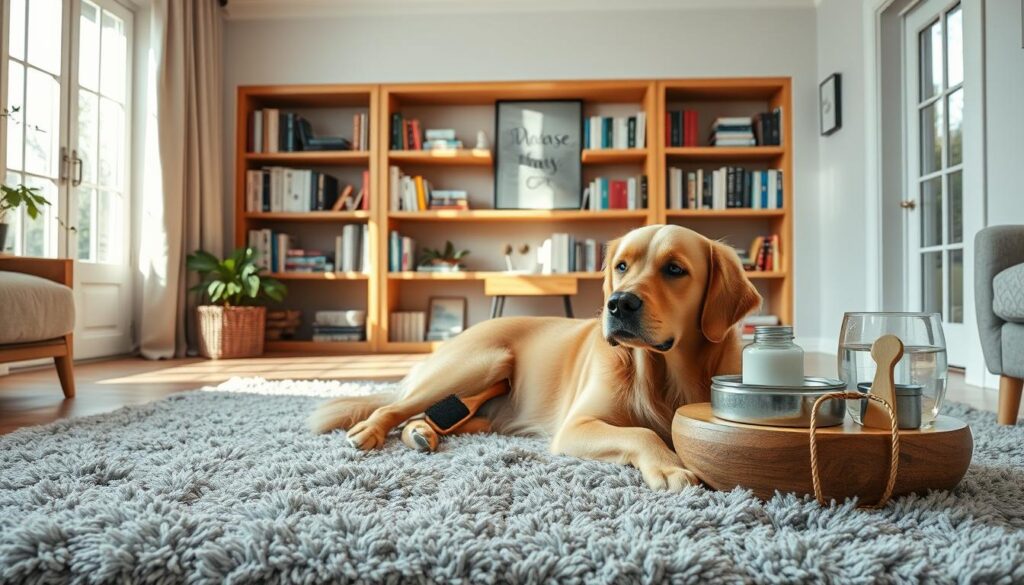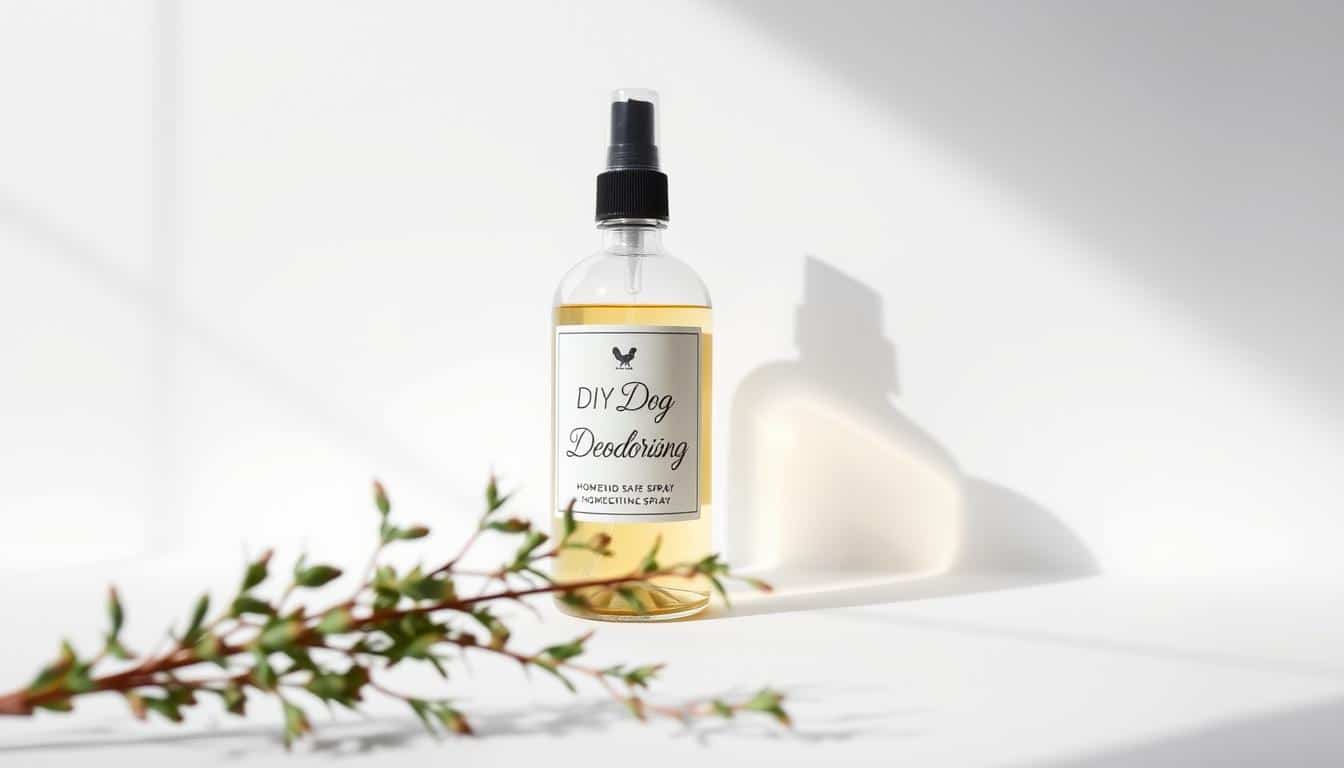Dog dandruff is when dead skin cells flake off, bothering our furry friends. This issue worries dogs and their owners, leading to the search for solutions. We’ll explore natural ways to keep your dog’s skin healthy and them feeling great.
Understanding Dog Dandruff
Dog dandruff is a common problem seen as flakes of dead skin in a dog’s fur, often near the tail. It comes from an imbalance in how the skin produces oil. When the sebaceous glands make too much or too little sebum, it causes seborrhea sicca (dry) or seborrhea (oily).
Keeping a dog’s skin healthy is important. Many things can throw off the balance, like dry air, allergies, or bad food. Knowing how to handle these factors can help your dog feel and look better.
Common Causes of Dog Dandruff
It’s vital to know why dogs get dandruff to treat it well. Environmental factors play a big role. Finding the cause can help owners make their dogs feel better.
Dry Environment
Dry air can harm your dog’s skin. Dogs need moisture, especially when it’s cold or the heating is up high. This can make their skin flake and feel uncomfortable.
External Parasites
Mites called Cheyletiella cause what’s known as “Walking Dandruff”. They damage the skin, leading to noticeable flakes and irritation.
Poor Nutrition
Lacking important nutrients hurts your dog’s skin. Not enough omega-3 and omega-6 fats can make their skin dry and flaky.
Skin Infections
Infections from bacteria or fungus make dandruff worse. If a dog’s skin is weak, these germs can grow, making irritation and flaking worse.
Skin Allergies
Sometimes, dandruff comes from allergies to food or the environment. These allergies also cause itching and swelling, so it’s important to find the cause.
Hormonal Issues
Problems with hormones, like Cushing’s disease or hypothyroidism, harm skin health. This can cause dandruff and increase the risk of infections.
Signs Your Dog Might Have Dandruff
Knowing the signs of dog dandruff helps tackle this common problem. Dogs show various signs when they have dandruff. These signs mean there might be skin issues to look into. Spotting them early lets owners act quickly.
Itchiness
Scratching more than usual is a clear sign of dog dandruff. This can make their skin red and inflamed. If not taken care of, it could get worse.
Skin Odor
A strong smell from the skin is another hint of dandruff. It usually means there could be an infection. In cases like these, seeing a vet is a good idea.
Excessive Dandruff
Seeing a lot of dandruff while grooming or petting is a big clue. This shows there might be more serious skin issues. It’s something that should not be ignored.
Hair Loss
Hair loss, especially in certain spots, often joins dandruff symptoms. It’s worrying and usually means a visit to the vet is needed. They can check for any serious conditions.
Natural Ways to Reduce Dog Dandruff
Treating your dog’s dandruff naturally boosts their comfort and health. Grooming your dog right plays a key role. It slashes flakes and helps their coat stay healthy. Let’s look at effective ways to beat dandruff.
Regular Grooming
Keeping your dog groomed is crucial for their coat and skin. It gets rid of dead hair and too much oil. This prevents flake buildup. Brush your dog often with the right tools. This doesn’t just cut down on dandruff. It also betters blood flow and spreads their natural oils.
Proper Bathing Techniques
Right bathing methods can really help with dog dandruff. Choose shampoos for sensitive skin or ones that fit your dog’s needs. Don’t bathe them too much as it can take away needed oils from their skin. Find a bathing schedule that keeps their skin clean yet moisturized.
Dietary Supplements
Talk to a vet about adding supplements to your dog’s diet. Omega fatty acids are great for keeping their skin hydrated and healthy. Adding these to your dog’s food fights dandruff naturally. It also makes their coat shiny.
The Importance of Hydration
Proper hydration is key to keeping your dog’s skin healthy. If they drink enough water, their skin stays moist and strong. Without enough water, their skin can dry out and flake, leading to dandruff.
This is even more important in dry areas where dogs can easily get dehydrated.
Make sure your dog can always get to fresh, clean water. Watching how much they drink helps spot signs of dehydration early. Symptoms of not drinking enough include a dry nose, feeling tired, and skin that doesn’t bounce back when pinched.
Helping your dog drink enough water is good for both their skin and overall health. Keep their water bowl full, and maybe get a water fountain to encourage more drinking. Keeping your dog hydrated can stop skin problems and keep their coat shiny.
Creating a Healthy Living Environment
Keeping a healthy home is key to improving your dog’s skincare. A tidy and airy space prevents skin problems like dandruff. Here’s what you can do:
- Regularly clean your dog’s bedding to minimize allergens and irritants.
- Ensure proper ventilation to promote air circulation, which helps in maintaining skin health.
- Monitor humidity levels, especially during the dry winter months. Using a humidifier can aid in keeping your pet’s skin hydrated.
- Avoid using harsh cleaning products that may irritate your dog’s sensitive skin.
- Keep your dog’s living area free from dust and pollen by regularly cleaning surfaces.
The Role of Humidifiers in Preventing Dandruff
Humidifiers play a key role in keeping dogs’ skin healthy, especially in dry winter months. Dry air leads to flaky skin and more dandruff. Humidifiers add moisture to the air, making a better living space for dogs.
By balancing humidity levels, your dog’s skin condition can improve a lot. Moist air keeps the skin hydrated, cutting down dryness. This step is vital for good dog skin care and their overall health.
In places with cold winters, using humidifiers can offset the bad effects of indoor heating. A balanced environment boosts your dog’s comfort and helps stop dandruff from forming.
When to Seek Veterinary Help
Knowing when to see a vet is crucial for your dog’s health. Sometimes, home remedies for dog dandruff don’t work because your pet might have a more serious issue. Problems like skin infections, allergies, or hormonal imbalances might need a vet’s care.
Identifying Underlying Health Issues
Still seeing dandruff after trying treatments? This could mean your dog has a bigger health issue. Look out for:
- Skin infections that need targeted treatments
- Allergies, which may require diagnostic testing
- Hormonal problems that can affect skin health
A vet can figure out the real reason behind the dandruff. They offer treatments that are just right for your dog’s specific needs.
Signs of Serious Conditions
Some symptoms mean you should get vet help right away. Watch for:
- Persistent itching that does not subside
- Severe hair loss leading to bald patches
- Unusual skin conditions, including redness or swelling
Getting help quickly is key. A vet can provide insight and a detailed treatment plan for your dog. If you see these worrying signs, make sure to get professional help.
Additional Tips for Dog Owners
It’s important for dog owners to watch their pet’s health closely. This helps avoid problems like dandruff. Notice any changes in how your dog acts, its energy, and the state of its skin.
Make sure to have regular vet visits. This is key for catching any issues early on.
Keep up with your dog’s grooming. Brush to get rid of loose hair and dirt. Grooming not only cleans the fur. It also boosts blood flow and spreads the dog’s natural oils. This makes the skin healthier.
Learning about what foods are best for your dog is crucial. Feed them high-quality food with lots of essential fatty acids. This is good for their skin and fur.
Don’t forget about exercise. It keeps your dog fit and reduces stress. Stress can mess with their skin. Simple things like walks or playtime outside can make a big difference in their health.
Using these dog care pointers in your daily routine will help. Your dog will be healthier and happier. This means less dandruff and a shinier coat.

Conclusion
Dog dandruff is a common issue but it’s not hard to manage. Knowing what causes it helps a lot. This includes things like where your dog lives or what it eats. Taking good care of your pet makes a big difference. This means regular cleaning and feeding them right.
Keeping an eye on dandruff signs is important too. This way, any big problems can be caught early. Making sure your dog has a good place to live is key. For example, using humidifiers can help. Being well-informed and proactive keeps your dog happy and healthy.
FAQ
What causes dog dandruff?
How can I tell if my dog has dandruff?
What natural remedies can help reduce dog dandruff?
How does dehydration affect my dog’s skin?
Are humidifiers beneficial for dogs with dandruff?
When should I consult a veterinarian regarding my dog’s dandruff?
How can I create a healthier living environment for my dog?
What dietary changes can help my dog with dandruff?
Can exercise contribute to my dog’s skin health?
Content created with the help of Artificial Intelligence.



